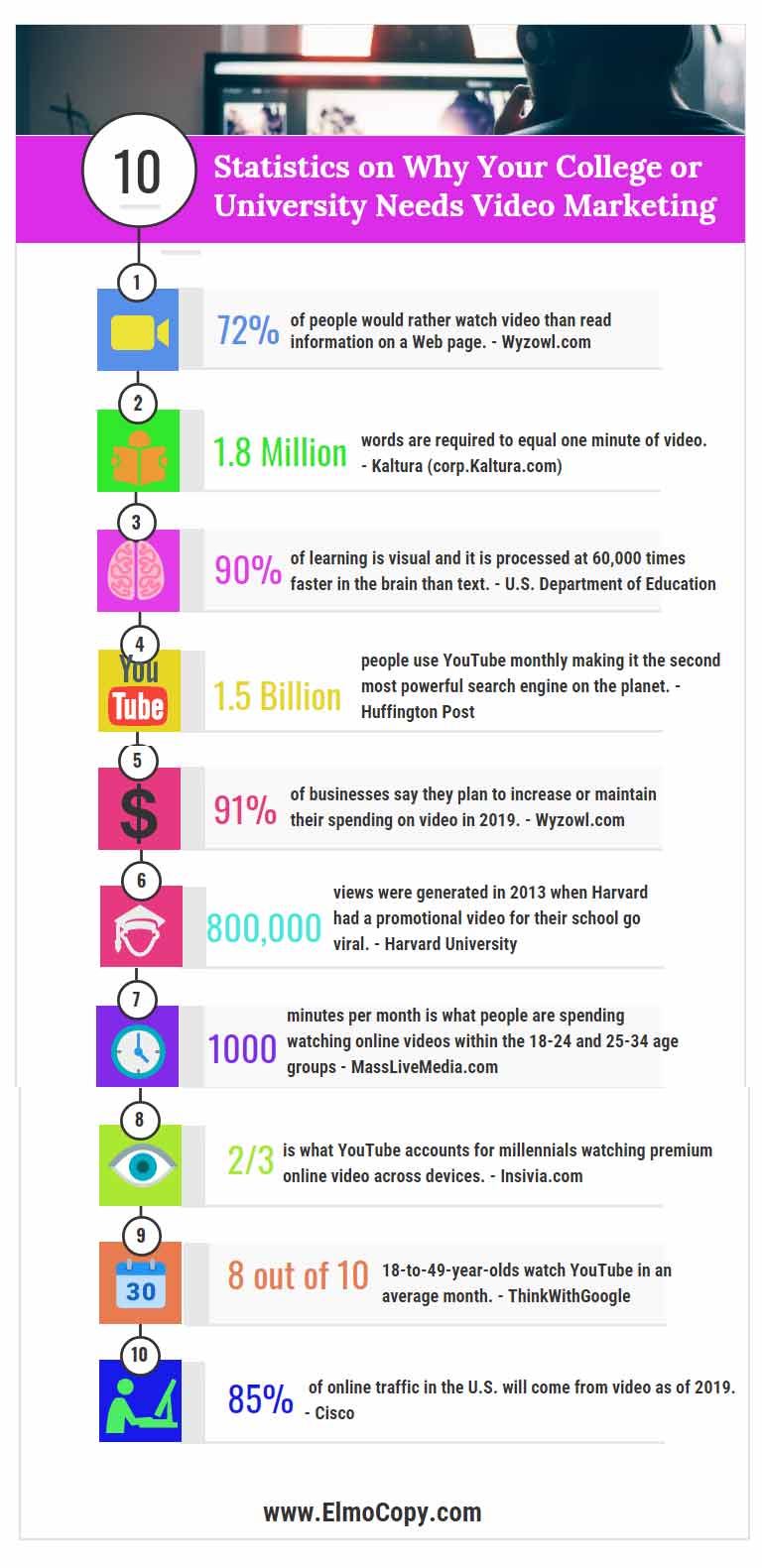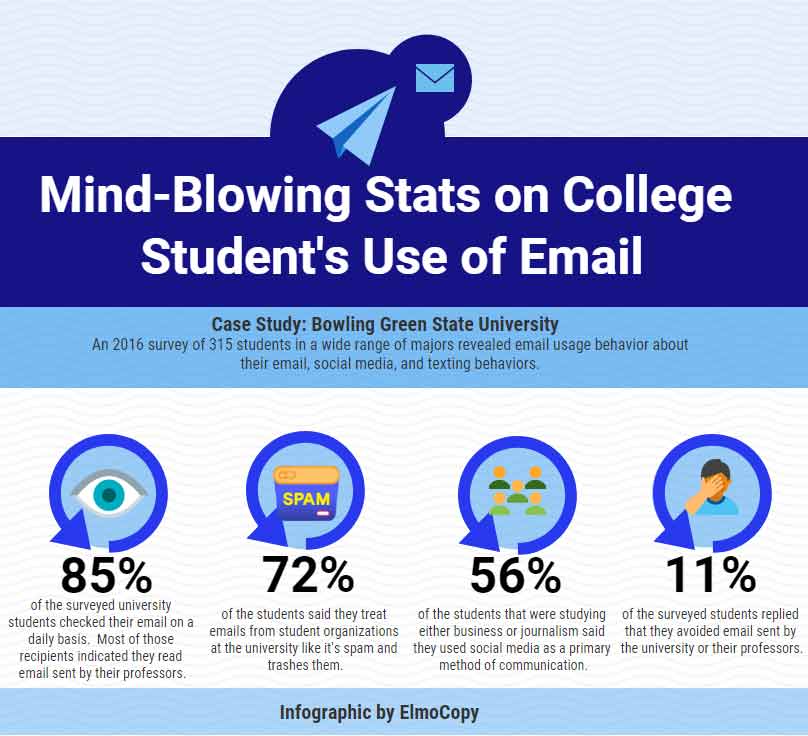If you’re a director of marketing or head of a communications department at a college or university, you need to be aware of these 40 digital marketing strategy statistics.
Considering how competitive the higher education scene is right now, you’d be crazy not to apply some of these ideas to your institution’s digital marketing strategy.
As you can see from Google Trends below, digital marketing has taken off like a rocket since 2004. In order for your college or university to stay competitive, you must embrace the digital marketing scene.

In this post, I’m going to share stats and ideas on how you can immediately increase your leads and conversion rates for your college or university. So if you work in a marketing capacity at one of these institutions, you’ll benefit from reading these stats and taking my advice.
Use Video in Your Digital Marketing Strategy Mix
There are all kinds of video content you can create to market your institution. There are vlogs, video ads, tutorials, live streaming, presentations, but the most popular and best type for a college or university is “explainer video”.
Explainer videos do exactly what their name sounds like — they explain a product or service using a short and concise video. If you decide to create a video of this type, it’s best to hire an instructional designer or copywriter to create a script for you.
Here’s an example of one I made a while back for Boise State University:
Students Respond Better to Video-Centric Content
Kaltura, a leading online video platform conducted extensive research on the impact that video has on students and young people.
Here’s what they found after surveying 500 educators from 300 different institutions:
- 81% of the respondents from this survey said that online learning will grow and will include the use of video instruction
- 49% of these respondents estimate that students were watching at least 20 educational videos a month
- 52% said that faculty was implementing video without the prompting of their supervisors
How can this apply to your digital marketing strategy?
The educational video force known as Udemy has been dominating its market space by requiring each course on its site to have preview videos.
Like Udemy, your institution could create short introductory videos for your courses so that students can get a taste of the material and its instructors.
For example, these videos could offer introductory information about what the course content is and what the student needs to do in order to succeed.
The animated video explainer company Wyzowl found that 72% of people would rather watch videos rather than read the information on a webpage.

Why Some Colleges and Universities are Crushing Their Competition with Video
If the previous stats on using video in your digital marketing mix didn’t influence you enough, here are a few more considerations:
- As of 2017, online video accounts for 74% of all online traffic (Kleiner Perkins)
- 64% of video viewers will watch more than three-fourths of a video (Syndacast.com)
- 54% of executives share work-related videos with colleagues every week (Tubular Insights)
- 55% of people watch videos online every day (MWP DigitalMedia)
- 75% of executives watch business-related videos on business sites rather than on YouTube (Tubular Insights)
- As of 2015, 93% of marketers use video as a part of their digital marketing strategy (Syndacast.com)
- 83% of senior executives stated they are watching more video online today than in the last year (Tubular Insights)
- Including a video on a landing page can increase conversions by 80% (Syndacast.com)
Action Steps for Using Video in Your Digital Marketing Strategy
If you’re wondering how you can start to immediately implement these strategies into your institution’s marketing mix, here are some action steps for you.
Action Step 1: Get a video on your home or landing page.
You don’t have to have a half-hour video on your landing pages. Just a short 1 or 2-minute introduction which highlights the top benefits your school offers its students.
Here is an example of a video by Rice University which appears on its homepage:
Action Step 2: Hire a Freelance Copywriter to Write Your Video Script
The potential revenue for a college to make by using an introductory video on its home page is staggering. The words and pacing you must use in it are vital to your school’s conversion rates and lead generation.
Regularly, you would hire a freelance copywriter to craft the words for your video script. A good copywriter will know how to highlight the benefits that are important to prospective students and get them to take action.
So hiring a copywriter that is experienced in writing video copy is extremely important and well worth the money.
Action Step 3: Use Videos to Introduce Your Courses
Short 2 to 3-minute videos with an introduction by the professor who will be teaching them are powerful.
You can highlight the course’s content, explain the benefits of taking the course, and introduce the instructor all at once! Once again, if the script is written by an experienced copywriter, your conversion rates will be much higher.
If your media department has the proper equipment and knows how to get the job done these intro videos can be knocked out very quickly.
Eye-Opening Email Marketing Stats for Universities and Colleges
Email marketing is not dead.
Convincing your marketing department that this is still one of the best ways to promote your school might be a daunting task.
As a digital marketing strategy, email trumps all the other digital marketing like video, social media, growth hacking, etc.
Why?
Because email can be used to deliver messages about those other platforms directly to your target market.
For example, if you have a Facebook campaign running, you can easily send a personalized message out to thousands of willing recipients about it. If you have a video going live you can do the same.
(There’s a key word in that last phrase you may want to consider carefully.)
Above all, an email will be very noticeable to your recipients because it can be personalized.
When you post videos or Facebook announcements, you have to generalize your message. However, you can send out an email with the recipient’s name on it announcing your post.
Therefore, email not only sends marketing messages to people that have already raised their hands to get your messages, but it can announce posts from other platforms as well.
Higher Education Email Marketing Stats You Can’t Ignore
However, if you’re still riding the fence on whether or not your school’s campaign should use email as a primary marketing force, take a look at these stats:
- 59% of people are influenced by email marketing when it comes to investment and buying decisions (SalesCycle)
- 90% of company emails reach their destination, only 2% of Facebook posts will reach their audience (The Manifest)
- Segmented email marketing campaigns can increase your revenue by 760% (Campaign Monitor)
- Millennials, on average, check use email 6 hours a day – 70% of them check it in bed (Adobe)
- 32% of millennials want fewer repetitive email messages (Adobe)
- 78% of millennials would rather spend money on an experience than an expensive object (Eventbrite)
- The number of email users worldwide is supposed to rise to 2.9 billion by 2019. (Statista)
- Nearly 105 billion emails are sent every day (Radicai)
- By 2020 there will be approximately 246 emails sent on a daily basis (Radicai)

If you look at the infographic above, you’ll see right away that college students check their email on a daily basis.
However, when you look at the other stats you’ll find that it’s not as easy as you think to send them messages.
How to Increase Your Email Open Rates Immediately
The majority of the students in the survey said that they ignore or trash email sent by student organizations. Also, over half of the respondents to the survey said they used social media to communicate instead of email.
There are several reasons why university and college email messages get trashed.
-
The subject line is boring.
This is email copywriting 101, but any title, headline, or email subject line you write must compel the audience to read it. We are vastly overloaded and bombarded with messages all day long, so your message must stand out and create a desire in the reader.
How to fix this problem:
- When you go through your daily email, swipe or collect the subject lines that really catch your attention and make you want to open read the message they accompany. Keep a file of those subject lines then adjust and use them on your own messages.
- Using key phrases like “How to…” at the beginning of your subject lines will increase your open rates immediately by 8%.
- Track what your open rates are and adjust your marketing to those responses. One of the best things about email is you can easily track your success with any aspect of the campaign. Open rates, click through rates, and other data is easily accessible to you from your email service company.
- Keep your messages as short, sweet and as concise as possible. 30 characters or less is a good number to shoot for. (One of my favorite tools for keeping my messages simpler is the Hemingway App. Its online version is free and if you want a copy of it for your computer, you can pay $20 to get it.)
[ctt template=”1″ link=”7cDTc” via=”yes” ]Using the words “How to…” in your email subject lines will increase your open rates immediately by 8%.[/ctt]
2. Too many technical terms.
Using technical jargon to impress students is a bad idea. A recent study by Chartbeat found that 55% of website visitors will spend 15 seconds or shorter on a webpage; it’s even less than that on email.
How to fix it:
- Once again, make sure that your messages are as simple as concise as possible.
- Never assume that the students you are writing to understand your terminology ― especially new students. Explain things in a manner anyone would be able to understand.
- Choose common terms that the students use every day. If you can, use phrases and a voice that students can relate to without pandering or dumbing down the information. (Yep, your students and prospects are sophisticated enough to know when they are being catered to unnaturally. )
3. Post Looks Overwhelming
Reading from a computer screen is different than reading from a book. Using formatting rules that you would use on a white paper is different than what you will use on a blog post or email message. If an online reader sees a large block of text in an email, there’s a large probability rate she will probably chuck you message into the trash file.
How to fix this:
- Only put one or two sentences together at a time. A paragraph block of text will not work on the Internet. (Extensive Research has been done on this by big-time marketers like Neil Patel.)
- Break up your writing by using different sized fonts, bold lettering, italicized words, bullet points, etc.
- Pictures work well if you are sharing an article with your students. However, if you are merely sending an announcement you may want to stick with a plain text message.
- Unless you actually have a ton of information to share, keep your messages short and as concise as possible.
4. Personalize Your Messages
Another powerful thing about email is that you can actually put the recipient’s name on it. Actually, you can automatically have their name inserted into the messages over and over again.
Most of the mainstream email services like Aweber, MailChimp, and Constant Contact have these functions built into their email services. All you have to do is press a button or two on one of the systems and automatically everybody on your email list will have their names inserted into the email.
You can even have their names inserted into the subject line automatically as well.
Why Using Social Media is a No – Brainer When it comes to Digital Marketing
There’s no question about the power of social media, especially when it comes to college students. But before we get into that specific crowd, let’s look at some general stats, shall we?
- As of 2019, almost 3.5 billion people are using social media or 45% of the world’s population (Hootsuite)
- There was 9% increase in the use of social media since 2018. That’s an additional 366 million people that’s jumping into this pool (Hootsuite)
- Worldwide social media spending increased by 32% and it’s expected to grow to an additional 73% over the next 5 years (Statista)
- 28% of digital marketers have already implemented social commerce or plan to do so over the next year. (Hootsuite)
But you probably already know the power of social media, so let’s take a look at what kind of impact it has on institutions of higher learning.
Studies have found that social media use among teenagers has been rather robust over the years.
In 2019 88% of 18 to 29-year-olds use social media and 51% of them say that social media would be difficult to give up. (pewinternet.org)
Also, 71% of teens say they are using multiple platforms of social media. (U.S. Department of Social Services)
2 Off – Beat Ways Colleges and Universities are Using Social Media to Promote Their Schools
What these stats indicate is if you are a college or university, your opportunity to market to prospective students is greater than just publishing information on your school’s site.
Texas A&M, for example, has s a twitter account that’s dedicated to the mission of recruiting students. The smart thing is that social media channel has been designed and is focused on that specific mission and nothing else.
Topics like student housing, financial aid, campus food courts and other aspects of campus living are discussed.
Another way schools can use social media in their digital marketing is by making it relatable.
Let’s face it, we all relate better to our own age group. You can easily capitalize on this by encouraging current students to post about different aspects of campus life and activities.
If the students at your school like your institute of higher learning, they can be your biggest advocates. By getting staff to encourage students to post about the different activities and classes, you can gain interest on a variety of social media channels.
Using Ads on Different Social Media Platforms
There are so many different ways of using social media to get the word out about your institution; it would take a book to discuss them all.
One of the most effective methods is to create posts that are really mini advertisements. Here is an example of one created by Trinity Christian College:

In this post, Trinity created a one minute video on the importance of their school’s history program. The video was very professionally created with a script and pacing that created a clear message.
The great thing about creating a video like this is it can be created in just a few hours and can be used on a wide variety of social media channels. Not only that but once created, it can be used for years.
Conclusion
As you can see by these digital marketing strategy statistics, there are a variety of digital marketing strategies and tools you can use to promote your school.
As I mentioned above, it would take a book to cover all the different social media platforms. Hopefully, I’ve given you enough information here to help you launch or maintain your own.
Please comment below and let me know what you think about this post. It would really make my day if you left one, and I will try to respond as soon as possible.

